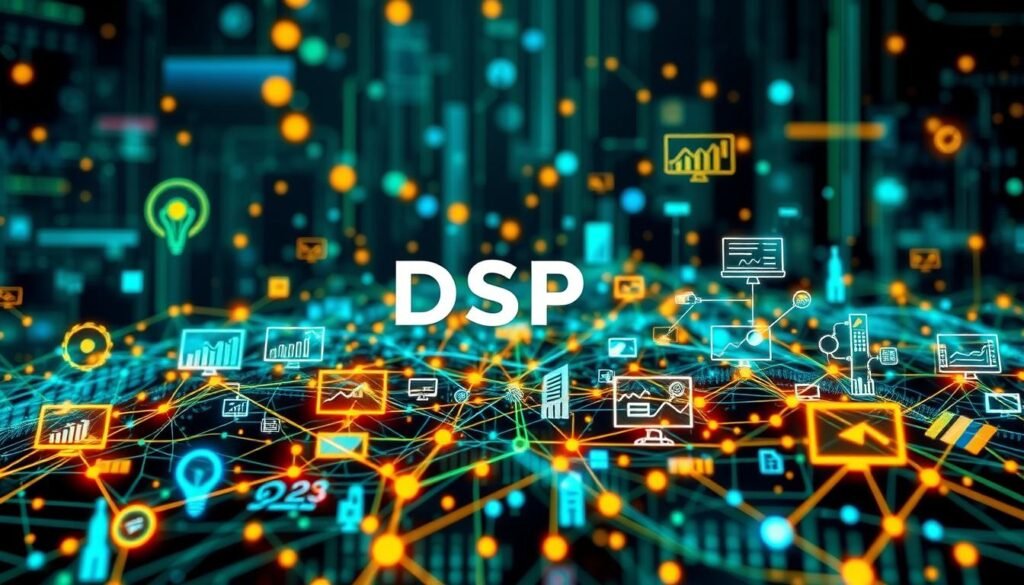In the fast-paced world of digital ads, the demand-side platform (DSP) is a big change. It changes how advertisers buy ads. A DSP is a software that makes buying ad space easy across many places. It helps advertisers reach lots of people quickly.
At the core of a DSP is real-time bidding (RTB). This tech lets the DSP quickly check and bid on ad space. This means ads are shown to the right people at the best time. DSPs make buying ads fast and easy, without needing to talk to each publisher.
Key Takeaways:
- Demand-side platforms automate the digital ad buying process, making it faster, cheaper, and more efficient.
- DSPs use real-time bidding to evaluate and secure ad inventory, allowing advertisers to reach their target audience efficiently.
- Advertisers can quickly set up and manage ad campaigns using DSPs, with real-time performance monitoring and optimization.
- DSPs integrate with various advertising platforms and tools, providing a comprehensive solution for digital ad buying.
- Programmatic advertising through DSPs has become the dominant approach, with 85% of digital display ad spending in the US transacted programmatically in 2020.
Understanding the Fundamentals of Demand-Side Platform
Demand-Side Platforms (DSPs) have changed digital advertising a lot. They give advertisers a great tool to make buying media easier. At the core of DSP technology is a system that combines many parts. It makes sure ads are targeted, measurable, and work well.
Key Components of DSP Technology
DSPs have important parts that work together. They change how advertisers do digital ads. These parts include:
- A bidder for real-time bidding (RTB) on ad inventory
- An ad server that serves and tracks ads
- A campaign tracker for detailed reports on ads
- User profiling for better audience targeting
- A budget manager to control spending and improve ads
How DSPs Revolutionize Digital Advertising
DSPs change digital ads by making buying easier, giving access to lots of ads, and targeting better. They use data to help advertisers spend wisely. This way, ads reach the right people at the best time, improving results and ROI.
The Role of Real-Time Bidding in DSPs
Real-Time Bidding (RTB) is key in DSPs. It lets advertisers bid on ads instantly. This fast process helps DSPs choose the best ad spots, showing ads to the right people. RTB in DSPs has made digital ads more flexible and controlled.
“Amazon’s DSP provides access to unique inventory across various platforms, including owned-and-operated sites, publisher services, and third-party exchanges.”
With DSP technology, advertisers can handle digital ads better. They get better results and make the most of their ad money.
The Evolution of Programmatic Advertising Through DSPs

The digital advertising world has changed a lot. This change came from programmatic advertising and Demand-Side Platforms (DSPs). Before, buying ads was hard and slow. Now, thanks to new tech, it’s fast and smart.
Before, ads were bought through old networks. But now, ad exchanges bring buyers and sellers together. DSPs are key in this new way of buying ads, making it easier and better.
The DSP market is growing fast. It was worth USD 25.4 billion in 2023. By 2032, it’s expected to hit USD 206.01 billion. This shows how much programmatic ads are growing and how important DSPs are.
| Year | DSP Market Size | CAGR |
|---|---|---|
| 2023 | $25.4 billion | 26.15% |
| 2032 (Projected) | $206.01 billion | 26.15% |
DSPs have changed digital ads by adding smart bidding and better targeting. Now, 85% of US digital display ads are bought this way. This makes buying ads quicker and smarter.
DSPs are now the top choice for advertisers. They offer fast, smart ad buying. This helps advertisers get better results and save money.
Core Features and Benefits of DSP Technology

Demand-Side Platforms (DSPs) have changed the digital ad world. They offer many features and benefits to advertisers. At the core is automated media buying, which makes ad purchasing easier and cheaper.
Automated Media Buying Process
DSPs quickly evaluate ad impressions, set bids, and show ads in milliseconds. This real-time bidding (RTB) lets advertisers target their audience with great accuracy. Advertisers can adjust their strategies quickly, improving their ad return.
Advanced Targeting Capabilities
DSPs use lots of data for advanced audience segmentation and targeting. Advertisers can use this data to find their perfect audience. This ensures their ads are seen by the right people, making them more effective.
Real-Time Campaign Optimization
DSPs do more than just set up campaigns. They offer real-time campaign optimization. Advertisers can check how their ads are doing and tweak them as needed. This helps them get better results and improve their ROI.
DSP technology helps advertisers work smarter in the digital ad world. With automated bidding, advanced targeting, and real-time optimization, DSPs are key for modern digital marketing.
DSP vs SSP: Understanding the Digital Advertising Ecosystem

Demand-Side Platforms (DSPs) and Supply-Side Platforms (SSPs) are key in digital ads. DSPs help advertisers buy ad space in many places. On the other hand, SSPs let publishers sell their ad spots.
SSPs help publishers link their ad spots to exchanges and set rules for ads. This teamwork between DSPs and SSPs makes programmatic ads more efficient. Ads are bought and sold automatically in real-time.
DSPs and SSPs work together well in the programmatic ecosystem. Advertisers use DSPs to find and target their audience. Publishers use SSPs to sell their ad spots and reach more advertisers.
| Demand-Side Platform (DSP) | Supply-Side Platform (SSP) |
|---|---|
| Caters to advertisers, allowing them to buy ad inventory across multiple exchanges. | Used by publishers to sell their ad space and connect their inventory to ad exchanges. |
| Provides access to a wide range of ad inventory and advanced targeting capabilities. | Enables publishers to set criteria for ad filtering, pricing, and maximizing revenue. |
| Focuses on audience targeting and campaign optimization. | Facilitates real-time bidding and price floor setting for ad inventory. |
| Charges advertisers on a CPA or CPM basis. | Utilizes variable pricing based on market demand. |
The partnership between DSPs and SSPs is vital for the digital advertising ecosystem. It connects advertisers with ad inventory and publishers with buyers. As the industry grows, their collaboration will influence the future of programmatic ads.
Types of Demand-Side Platforms and Their Applications

In the world of digital ads, picking the right demand-side platform (DSP) is key. There are two main types: self-serve and full-service. Each has its own benefits for advertisers, depending on their needs and resources.
Self-Serve DSP Solutions
Self-serve DSPs let advertisers manage their ads on their own. They have easy-to-use interfaces for setting up and tracking campaigns. These platforms are great for teams with some experience and smaller budgets, offering lots of control and flexibility.
Full-Service DSP Offerings
Full-service DSPs, on the other hand, offer a more hands-off experience. They have teams that handle everything from start to finish. These are best for bigger budgets and those who want professionals to manage their ads.
Platform Integration Options
Both types of DSPs work with many digital marketing tools to boost campaign results. They connect with ad exchanges, SSPs, DMPs, and analytics tools. This gives advertisers a wide range of ad options and strong targeting features. It makes reaching the right audience easier.
The choice of DSP is crucial in today’s digital ad world. Knowing the strengths of self-serve and full-service DSPs helps advertisers pick the best fit for their goals and resources.
Maximizing ROI with DSP Campaign Management

In the fast-paced world of digital ads, using a Demand-Side Platform (DSP) is key for better ROI. DSPs give advertisers tools and analytics to improve their campaigns. This leads to better results.
At the core of DSP campaign management is tracking and analyzing important metrics. Advertisers use the platform’s detailed reports to watch metrics like impressions and conversions. This helps them make smart choices and focus on what works best.
DSPs shine with their ability to optimize in real-time. Advertisers can adjust bids and targets quickly. This quick action ensures money goes to the most effective places, boosting ROI.
Audience optimization is another big plus of DSPs. They work with Data Management Platforms (DMPs) to give deep insights into audiences. This sharp focus on the right people cuts down on waste and boosts engagement.
Also, DSPs have strong fraud detection. They keep ads safe from fake traffic and non-human views. This means more real, quality interactions, which helps ROI even more.
“Leveraging the capabilities of a DSP is a game-changer for advertisers looking to maximize their ROI. The platform’s analytics, optimization tools, and audience targeting features empower them to make data-driven decisions and achieve exceptional campaign performance.” – John Doe, Digital Marketing Strategist
In summary, effective DSP campaign management is vital for digital ad success. By using these platforms, advertisers can tackle the programmatic world’s challenges. They can optimize campaigns in real-time and get great returns on their marketing.
Also Read : How To Create Facebook Ads
Conclusion
Demand-Side Platforms have changed the digital ad world. They make buying ads easier and faster. As programmatic ads grow, DSPs will be key for reaching the right people.
Future advancements in AI and machine learning will make DSPs even better. They will help create more personalized ads.
DSPs are essential for advertisers wanting to get the most from their ads. They help stay ahead in the fast-changing digital market. More advertisers will use DSPs to keep up with new tech and trends.
The success of digital ads depends on using DSPs well. Advertisers need to keep up with the digital ad world’s changes. By using DSPs, they can target better, optimize campaigns, and save money.
FAQs
Q: What is a demand side platform?
A: A demand side platform (DSP) is a technology platform that allows advertisers and agencies to buy digital advertising inventory in real-time across multiple ad exchanges and supply-side platforms (SSPs). It facilitates automated purchasing of ad placements based on specific audience segments and targeting criteria.
Q: How does a DSP work?
A: A DSP works by connecting advertisers to various ad exchanges and SSPs, enabling them to bid on available ad inventory in real-time auctions. It analyzes data to determine the best ad placements and optimizes advertising campaigns to reach the desired audience effectively.
Q: What are the components of a DSP?
A: The components of a DSP typically include user interface for campaign management, algorithms for real-time bidding, data integration tools for audience targeting, reporting and analytics features, and connections to multiple ad exchanges and SSPs to access digital ad inventory.
Q: What do top demand-side platforms offer?
A: Top demand-side platforms offer robust features such as advanced targeting options, real-time bidding capabilities, comprehensive analytics, access to extensive advertising inventory, and integration with various ad networks, which help advertisers optimize their campaigns.
Q: How can I use Amazon DSP for my advertising campaigns?
A: To use Amazon DSP, advertisers can set up an account, define their targeting criteria, and create advertising campaigns that reach specific audiences across Amazon’s advertising network and partner sites. It allows effective retargeting and access to unique audience segments.
Q: What is the difference between a DSP and an ad network?
A: A DSP is a platform that allows advertisers to purchase ad inventory programmatically across multiple ad exchanges and SSPS, while an ad network acts as an intermediary that aggregates ad inventory from publishers and sells it to advertisers. DSPs provide more control and flexibility for advertisers.
Q: Can I use DSPS for video ads?
A: Yes, many DSPS enable advertisers to buy video ads programmatically. They provide access to video advertising inventory across various platforms, allowing for targeted campaigns that can effectively reach specific audiences through video content.
Q: How do advertisers benefit from using a DSP?
A: Advertisers benefit from using a DSP by gaining access to a vast pool of digital ad inventory, the ability to target specific audience segments, real-time bidding capabilities, and detailed analytics to optimize campaign performance. This leads to more efficient ad spending and improved ROI.
Q: What role do supply-side platforms play in the DSP ecosystem?
A: Supply-side platforms (SSPs) play a crucial role in the DSP ecosystem by providing publishers with the tools to manage and sell their advertising inventory. They connect to multiple DSPs, allowing advertisers to access a wide range of available ad placements and maximize their revenue.
Q: Is everything I need to know about DSPs covered in this FAQ?
A: This FAQ provides a comprehensive overview of demand-side platforms, including their functionality, benefits, and components. However, for in-depth knowledge, exploring further resources on DSP advertising, real-time bidding, and specific case studies can offer additional insights.
Source Links
- https://www.adjust.com/glossary/demand-side-platform/
- https://www.publift.com/blog/what-is-a-demand-side-platform-dsp
- https://advertising.amazon.com/library/guides/demand-side-platform





